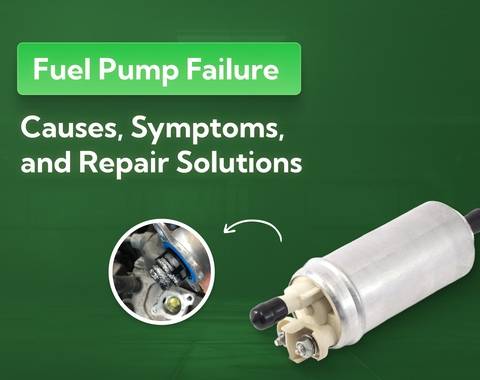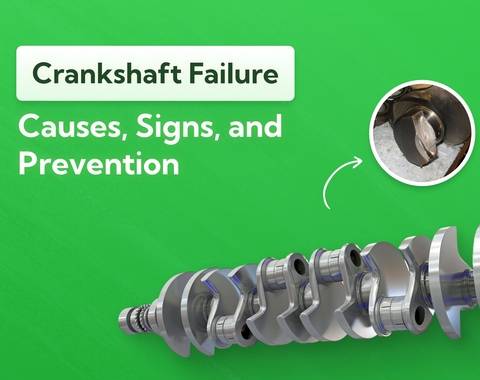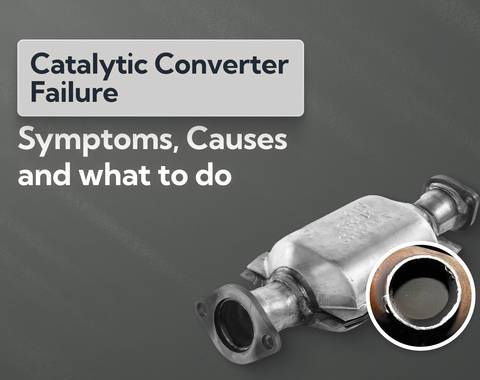Buying a Used Car: The Ultimate Checklist for 2025
If you're in the market for a used car, there are a few things that can help you prepare for the process. In this article, we'll break down your different financing options, what to look for when evaluating a used car, and details to verify with the seller before finalising the purchase.
Last updated: 23rd October, 2025

Anthony Sharkey is COO at New Reg Limited (Car.co.uk, Trader.co.uk, Garage.co.uk), driving innovation in vehicle recycling, logistics, and customer experience.

Listen to this story
If you're in the market for a used car, there are a few things that can help you prepare for the process. In this article, we'll break down your different financing options, what to look for when evaluating a used car, and details to verify with the seller before finalising the purchase.
Since cars depreciate so quickly, buying a model a few years older on the second-hand market is a great way to save money while getting a car with nearly identical safety and technology features.
That said, buying a used car does come with its own set of challenges and risks. Since it's pre-owned, its future maintenance requirements and overall condition are somewhat unknown. And there are scams to watch out for, even if you're buying from a seemingly reputable dealer.
To maximise your potential for buying a reliable and cost-effective used vehicle, follow our comprehensive used car buying guide.
What's in this article
- 1. What to check first when looking at a used car
- 2. How do I verify a used car's maintenance history?
- 3. What questions should I ask the seller about the car's history?
- 4. Red flags in a used car's exterior condition
- 5. Why is checking a used car's interior condition important?
- 6. What to look for under the hood of a used car
- 7. Testing the functionality of a used car's electronic features
- 8. Why is a test drive crucial when buying a used car?
- 9. Assessing the car's suspension during a test drive
- 10. Checking for signs of engine problems
- 11. Identifying hidden accident damage
- 12. Common scams to watch out for when buying a used car
- 13. Final thoughts
What to check first when looking at a used car
When you're shopping for a used car in the UK, your #1 concern should be thoroughly checking each prospect's history and documentation. That way, you'll know upfront whether the seller is legit and if you're getting a good deal. You don't want to spend days going back and forth with a seller only to find out they've been dishonest about the car's condition or ownership history.
Before spending time on a physical inspection, here are the key areas to focus on:
1. Check the vehicle's history report (HPI).
An HPI Check is a comprehensive vehicle history report you can purchase online for a small fee (starting at £9.99). On the official HPI Check website, you can do this for any car (or ask the seller to provide it), and it'll reveal whether that car...
- has been in an accident
- been written off (and which salvage category)
- has any outstanding finance on it
- has mileage discrepancies
- was imported/exported at some point
- was reported stolen
The HPI Check is a prerequisite for any used car purchase — not only can it protect you from buying a car that has hidden issues, but it can also reveal if the seller is trying to scam you. And it'll save you from serious legal liabilities you could face if you buy a stolen or unroadworthy car.
2. Verify MOT history.
The MOT test is an annual test that verifies a car's roadworthiness, safety, and environmental compliance. UK law requires every car older than three years to have a valid MOT certificate, which is earned by passing the test.
A dodgy (or missing) MOT history is a clear indicator that the car hasn't been properly maintained or is unsafe to drive. If the seller leaves its lack of MOT certificate out of their car's details, they're probably trying to hide other things as well.
You can check any car's MOT history for free using our free MOT checker. The process takes a few seconds — all you have to do is enter its registration number. From there, we'll show you its current status, previous results, advisory notes, and points of failure.
3. Ask for the V5C logbook.
The V5C logbook is the most important document when selling a car. There are only a few ways you can sell a used car without a V5C.
Verify that the seller can provide the V5C logbook and that the details match the car, including the Vehicle Identification Number (VIN) and engine number. Also check for a watermark on the document to ensure it’s genuine.
If the seller cannot present this, it's an immediate red flag. You're either buying a car that's not legally theirs to sell, or it's stolen. On top of that, the V5C also contains information about the car's past owners and service history.
4. Understand the car's market value.
Compare the used car’s price with similar models in the market to ensure you’re getting a fair deal. There are a few ways to do this:
- Use our instant car valuation calculator to get a baseline estimate.
- Look for similar listings across local dealerships and car selling websites.
- Account for factors like seasonality and make/model.
This will give you a foundational understanding of what the car's worth, which will help you in negotiations and more subjective aspects of the valuation process (e.g., for any modifications or cosmetic damages).
5. Look at service history.
A complete service history indicates the used car has been well-maintained. Check for consistent records of servicing at regular intervals, and verify that they correspond with the car's mileage.
By reviewing these records, you can get an idea of the car's maintenance history and catch any potential issues before they become major problems. For example, if the car has 50,000 miles on it and no records of replacing the brake pads or discs, you know you'll be spending ~£500 sometime in the next year or two to get that done.
How do I verify a used car's maintenance history?
The easiest way to verify a used car's maintenance history is to ask for the service records from the previous owner. You can obtain these from a dealership or individual seller, and they'll show any work that has been done on the car.
That includes:
- Regular maintenance, like oil changes and tire rotations
- Larger repairs, like replacing parts or fixing damage
- Recalls or warranty work that was completed
Look for any gaps in the history, which could indicate that the car wasn't properly maintained or likely has underlying mechanical issues. Also, note the name and address of the garage or mechanic who performed the services — this can be useful for future reference.
What questions should I ask the seller about the car's history?
Asking the right questions about a used car you're interested in buying helps you uncover hidden issues and get a clear picture of the car's history.
Here are some essential questions to ask the seller:
- Why is the car for sale?
- How long have you owned the car?
- How many previous owners has the car had?
- Can I see the car's maintenance records?
- Are there any outstanding finance or title issues?
- Has it been in an accident?
- Are there any ongoing recalls or warranties?
- What recent repairs or replacements have you made?
- What is the condition of the tyres and brakes?
- Are there any interior or exterior defects I should know about?
- Has the car passed its most recent MOT?
- Can I have the car inspected by an independent mechanic?
- Can I take the car for a test drive?
While some of these questions you can verify yourself, you want to ensure the seller can verify it for you. A transparent seller will have a legitimate reason to sell the car, know all about its history, and have all the necessary documents to prove it. They'll be more than willing to let an independent mechanic inspect it, and they'll be happy to let you test drive it.
Red flags in a used car's exterior condition
Once you've made it past the initial screening, you can move forward with your in-person inspection. We recommend bringing someone with you who is knowledgeable about cars or hiring an independent mechanic to conduct a thorough inspection.
As you're examining the car, be on the lookout for these red flags in its exterior condition:
- Dents and scratches
- Rust (particularly around the wheel arches, door sills, and the underside of the car)
- Misaligned panels with large or uneven gaps
- Cracks or chips in any glass components
- Tyre tread depth above the legal minimum (1.6mm)
- Lights and indicators responsiveness, brightness levels, and condensation inside the lens
- Paint color inconsistencies (which could indicate previous repairs)
- A 'bounce test' (pushing down on each corner to check for worn shock absorbers)
Some exterior issues will turn into maintenance costs in the near future — for instance, worn tyres or faulty lights. Others, like rust, can turn into severe structural damage if left unchecked.
Why is checking a used car's interior condition important?
The interior condition of a used car is equally important as the exterior. It not only affects the car's overall appearance and comfort but can also reveal potential underlying issues like water damage or leaks. Some interior components, like airbags, also seriously impact the vehicle's overall safety.
Pay attention to the following when inspecting a car's interior:
- Overall cleanliness and condition of carpets, seats, and dashboard
- Musty smells or dampness (which could indicate water damage)
- Proper functioning of all features (e.g., air conditioning, windows, radio)
- Wear and tear on steering wheel, pedals, and gearstick
- Airbag warning lights (this could indicate a faulty airbag system)
- Seatbelt functionality and condition (even small tears will fail the MOT)
- Accessory condition, including spare tires and repair kits
- Technology features, like Apple CarPlay, Android Auto, and Bluetooth
What the experts say

Steven Jackson OBE
What to look for under the hood of a used car
Under the hood is where you'll find the car's engine and mechanical components. These tell you a lot about the car's performance, reliability, and potential future costs. Since they'll wind up being some of the largest expenses, you definitely don't want to miss this stage of the inspection.
Here's what you should look for under the hood:
- Signs of rust, corrosion, and oil leaks/stains
- Belt and hose condition (should be clean, firm, and free of cracks/frays)
- Battery condition and corrosion on terminals
- Engine oil (check the dipstick for dark brown or black oil —milky oil could indicate water contamination)
- Coolant (should be a bright color — green, orange, etc — milky, brown, or rusty coolant suggests a bad head gasket)
- Power steering fluids (topped up and free from particles)
- Wiring tampering or damage
- Knocks, ticks, or other unusual noises when running the engine
Be wary of an overly-clean-looking engine. It could be a sign of a seller who’s trying to mask potential issues.
Testing the functionality of a used car's electronic features
Modern cars are equipped with sophisticated electronic features that make our driving experience more enjoyable and convenient. These features can also be a source of potential problems and expensive repairs.
When inspecting a used car's electronic features, keep an eye out for the following:
- Malfunctioning infotainment system (radio, navigation, Bluetooth)
- Faulty sensors or warning light indicators (check engine, tire pressure, ABS)
- Broken or non-responsive power windows and door locks
- Inconsistent performance of automatic features (e.g., wipers, headlight beams)
- Malfunctioning air conditioning and heating system
- Backup and side cameras (if the car has them)
- Sunroof functionality
- Battery voltage (it should read between 13.7 and 14.7 volts)
- Key fob buttons and electronic locks
Most features are easy to check. All you have to do is activate them or use them during your test drive (more on this next). If they don't work, you'll know there's an issue.
For anything having to do with the car's computer system and safety features, use an OBD-II scanner to read the car's diagnostic codes.
Why is a test drive crucial when buying a used car?
The test drive is where you get a feel for what it's like to actually drive the car. While it's possible for the car to look great and pass all of your inspections, it might not feel right when you're behind the wheel.
Here are some things you should pay attention to when you get behind the wheel:
- Acceleration and braking — Test how the car accelerates and brakes, paying attention to any unusual noises, vibrations, and issues with gear shifting (for petrol and diesel cars). Use the brakes at various speeds to ensure they provide strong, even stopping power even for highway driving.
- Steering and handling — The car should respond smoothly to uneven surfaces and accurately to your steering inputs. If you notice any pulling or drifting, it could be a sign of alignment or suspension issues. Slack in the steering wheel or difficulty turning could indicate a potential problem with the power steering system.
- Noise levels — Listen for rattling and grinding sounds while driving. These could indicate mechanical problems that may require costly repairs.
- Electronic features — Using the corresponding buttons and switches all the car's different electronic features — infotainment, climate control, lights/indicators, mirrors, and power windows. If it has a backup camera or side-view cameras, test those as well.
- Comfort and ergonomics — Consider how comfortable and easy it is for you to drive. Check the seat adjustments, legroom, headspace, visibility, and ease of accessing all of the car's functions.
- Road test — If possible, take your potential new car for a drive on different roads — city streets, highways, and backroads to see how the car performs on a variety of terrains.
You should also consider the overall feeling you have when driving. Some cars immediately feel like they're 'yours' — like the perfect fit. Others will feel awkward or uncomfortable for you, personally, even if they're objectively good across all these other evaluation points.
Assessing the car's suspension during a test drive
The suspension is responsible for a car's handling and ride comfort. It's also one of the most expensive systems to repair or replace, so keeping an eye on its condition during your inspection and test drive can save you lots of money and time in the shop.
Aside from the bounce test, here are some things you should look out for when testing the suspension:
- Excessive steering wheel vibration while driving at higher speeds (this could indicate worn shocks or struts)
- Bouncing or swaying when driving over uneven surfaces
- Uneven tire wear (especially on the inside of tires)
- Difficulty turning or maintaining control while driving
- Nose-dive when braking hard
If you notice any of these issues, there’s a good chance the vehicle has suspension problems.
Checking for signs of engine problems
Engine problems can be a bit harder to spot, but there are some tell-tale signs to look out for when inspecting a used car.
These include:
- Smoke coming from the exhaust (blue smoke suggests burning oil, white smoke suggests burning coolant)
- Leaks under the car (oil, transmission fluid, brake fluid, coolant)
- Unusual noises (knocking, ticking, rattling)
- Hesitation or stalling when accelerating
- Rough idling (the car shakes while running)
- Fluid leaks (oil, coolant, transmission fluid)
- Burning smells
Identifying hidden accident damage
A car that has been in an accident can still look great on the surface, but it could have hidden damage underneath. Shoddy or incomplete repair work is entirely possible, as is an accident the owner decided not to report to their insurance company.
Some signs of hidden accident damage include:
- Doors and panels out of alignment
- Inconsistent paint color or texture
- Unusual gaps between panels
- Trunk or hood not closing properly
- Rust or corrosion in unusual places
- Strange noises when opening/closing doors and trunk
Note: For 100% certainty, it's best to work with a trusted third-party mechanic to identify suspension and engine problems or hidden accident damage.
Common scams to watch out for when buying a used car
Some private sellers (and even dealerships) may dishonestly try to hide or downplay some issues with the car. They might even fraudulently pass off a car with major problems as being in excellent condition.
Here are some common scams to watch out for:
Odometer rollback (clocking)
This involves tampering with the odometer to show lower mileage than the car has actually traveled, making it appear newer and therefore more valuable.
To avoid this, check the car's MOT history and compare it with the current mileage. Look for signs of excessive wear that don't match the displayed mileage, such as a worn-out steering wheel or pedal covers.
Cut-and-shut
This is when two cars that have been written off in accidents are welded together, creating a single functional vehicle. These cars are often dangerous as they may have compromised structural integrity and safety, which is why they're illegal in the UK.
Cloning
When criminals steal a car to sell, they'll replace its identifying details with those of a legally registered vehicle. This scam can result in you buying a stolen car, which can be seized by the police.
To prevent this, verify that the Vehicle Identification Number (VIN) and engine number match the details in the V5C logbook. Use a vehicle history check (HPI Check) to ensure the car isn't stolen.
Curbstoning
This involves unlicensed dealers posing as private sellers to avoid regulations that come with reselling used cars. These sellers often sell cars that are unsafe or have hidden issues. Always meet the seller at their registered address, check the V5C logbook, and verify the seller's identity and address.
Ghost brokers
Ghost brokers are fraudsters who pose as insurance brokers and sell fake or invalid insurance policies. They might cancel the policy shortly after purchase, leaving you without coverage.
When choosing a car insurance policy, ask for the vendor's registration number with the Financial Conduct Authority (FCA). To check with the FCA, all you have to do is visit their website and enter their company name or FCA number.
Final thoughts
When you're ready to buy your used car, you have two options: paying cash for it or financing it. If you don't have the liquid funds (or simply don't want to make such a big upfront purchase), you can opt for dealership financing or secure a loan from a bank or credit union.
When it comes to financing a used car, you have a few options:
- Personal contract purchase (PCP) — Paying a deposit (usually 10-20% of the car’s value) followed by low monthly payments. At the end of the term, you have the option to make a final "balloon" payment to own the car, return the car, or trade it in for a new one.
- Hire purchase (HP) — Pay a deposit and then repay the remaining balance plus interest in monthly installments. Once all payments are made, you own the car outright.
- Personal loan — You borrow the money needed to buy the car from a bank, credit union, or other finance provider and repay it in fixed monthly installments over an agreed period. This option gives you immediate vehicle ownership.
- Fixed sum loan — Similar to a personal loan, but the interest rate and monthly payments are fixed for the duration of the loan.
- Dealer financing — This can include HP, PCP, or even 0% APR deals.
When you're ready to start the process, we're here to help. Get started with our free car finance calculator, get a quote through our system, and use our resources to help you secure the best deal possible.
And when it's time to evaluate different vehicle options, enter their registration into our free car valuation tool and MOT history checker to get a foundational understanding of the condition and value of each car you're considering.
About Car.co.uk

Share on
Latest news & blogs










